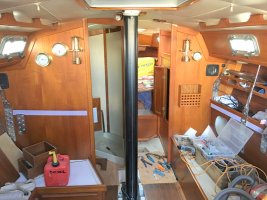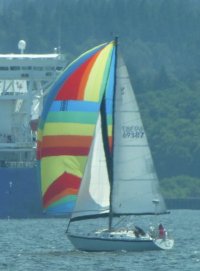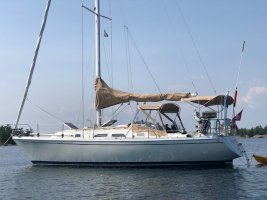I am a newbie working on the purchase of a 1988 34-2. Surveyor noted that the chain plates located behind the seats in the main cabin were not accessible for inspection. There are steel rods running down through the shelves and behind the seats (3 on each side). Does anyone have suggestions on the the best way to get access? Does it require drilling holes in the teak casing and, if so, what is directly behind? Is the seat-back removable? I'm concerned about the risk of the unknown condition, but want to resolve the issue without doing unnecessary damage . . .
You are using an out of date browser. It may not display this or other websites correctly.
You should upgrade or use an alternative browser.
You should upgrade or use an alternative browser.
Chain plate inspection
- Thread starter ALW
- Start date
-
- Tags
- access chainplate inspection
My model is built with the same shroud support system. The lower part of the Navtec SS rod is threaded into a large solid aluminum bar, located behind each seat back. On our boat I long ago pulled off the teak panel/ back by removing the plugs and extracting the ss screws.
I would guess that other owners of late-80's E-34 boats will be checking in with pertinent advice.
There is a heavily-laminated piece of frp behind each seat back and that transfers the shroud load down into the grid system.
I would guess that other owners of late-80's E-34 boats will be checking in with pertinent advice.
There is a heavily-laminated piece of frp behind each seat back and that transfers the shroud load down into the grid system.
supersailor
Contributing Partner
Welcome to the forum. This spot is one of the neat things about Ericsons.
The shroud loads are not carried by chain plates as such but by Navitech rods attached to the Triaxial Force Grid (TGAF} that reiinforces the underside of the hull. The rods can be seen above the seat backs. The actual attachment is an aluminum billet held by the fiberglass TGAF. There are no connections to wood and the rod is in open air the whole way down. This is a superior method that doesn't rely on a bulkhead. The panel on the seatback is glued and screwed on. It is removable but with difficulty.
I had a near sinking incident caused by the previous owner using ace hardware under sink hardware for the galley sinks and the hose slipped off causing a major leak. If you want to see more, go to the lifestyle and living section. About 2/3 the way down the page is a post called Terra Nova flooding. It's the ramblings bringing Terra Nova back to life after the sinking incident. The pix show most of the hidden parts of the boat.
I labored for a year+ on it and it is beautiful again. I would not have done this for most boats but this one is special.
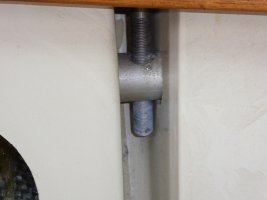
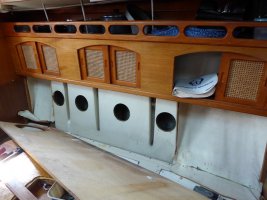
The shroud loads are not carried by chain plates as such but by Navitech rods attached to the Triaxial Force Grid (TGAF} that reiinforces the underside of the hull. The rods can be seen above the seat backs. The actual attachment is an aluminum billet held by the fiberglass TGAF. There are no connections to wood and the rod is in open air the whole way down. This is a superior method that doesn't rely on a bulkhead. The panel on the seatback is glued and screwed on. It is removable but with difficulty.
I had a near sinking incident caused by the previous owner using ace hardware under sink hardware for the galley sinks and the hose slipped off causing a major leak. If you want to see more, go to the lifestyle and living section. About 2/3 the way down the page is a post called Terra Nova flooding. It's the ramblings bringing Terra Nova back to life after the sinking incident. The pix show most of the hidden parts of the boat.
I labored for a year+ on it and it is beautiful again. I would not have done this for most boats but this one is special.


My model is built with the same shroud support system. The lower part of the Navtec SS rod is threaded into a large solid aluminum bar, located behind each seat back. On our boat I long ago pulled off the teak panel/ back by removing the plugs and extracting the ss screws.
I would guess that other owners of late-80's E-34 boats will be checking in with pertinent advice.
There is a heavily-laminated piece of frp behind each seat back and that transfers the shroud load down into the grid system.
Thanks Loren! This is very helpful to know what the system configuration is and what is behind the panel. It sounds like the panel is not required for the seat back, and you have elected to just leave it off for simplicity. Have you ever heard of corrosion issues at the interface of the steel rod and aluminum bar?
Welcome to the forum. This spot is one of the neat things about Ericsons.
The shroud loads are not carried by chain plates as such but by Navitech rods attached to the Triaxial Force Grid (TGAF} that reiinforces the underside of the hull. The rods can be seen above the seat backs. The actual attachment is an aluminum billet held by the fiberglass TGAF. There are no connections to wood and the rod is in open air the whole way down. This is a superior method that doesn't rely on a bulkhead. The panel on the seatback is glued and screwed on. It is removable but with difficulty.
I had a near sinking incident caused by the previous owner using ace hardware under sink hardware for the galley sinks and the hose slipped off causing a major leak. If you want to see more, go to the lifestyle and living section. About 2/3 the way down the page is a post called Terra Nova flooding. It's the ramblings bringing Terra Nova back to life after the sinking incident. The pix show most of the hidden parts of the boat.
I labored for a year+ on it and it is beautiful again. I would not have done this for most boats but this one is special.
These photos are great! I am sorry for the major leak that provided the photos, but I will certainly go study the posting and see what I can learn; especially since I'm expecting to need to replace a hose or two under the galley sink very soon.
It appears that the Navitech rods are threaded directly into the aluminum bar Loren described. I suppose that allows the rod to be removed from above without tearing into the seat back. With the help of these photos, I may consider removing the entire teak panel or simply creating small "inspection ports" in the panel so I can easily see the base of the rods.
By the way, I had sorted through lots of papers, then tons of useless online links trying to get a bit smarter about these rods; then I found this Forum. The responses from Loren, Christian and you have been fantastic! I am pretty happy to have found this place.
Alan
Thanks Loren! This is very helpful to know what the system configuration is and what is behind the panel. It sounds like the panel is not required for the seat back, and you have elected to just leave it off for simplicity. Have you ever heard of corrosion issues at the interface of the steel rod and aluminum bar?
I am sorry not to be clearer, but I do keep the teak-face seat backs in place all the time. The first time I removed them to see what's back there I did take out the teak plugs over the screws. Since the the upholstery covers the whole panel except for a couple inches along the top, there was never any reason to have those screws plugged in the first place, IMHO. This way I can remove the screws and the seat backs in under 5 minutes.
See the first picture in this blog entry, after the cushions have once again been moved home for the winter. http://www.ericsonyachts.org/infoexchange/entry.php?664-Lee-Cloth-quot-Quick-Connect-quot
Corrosion? Yes, but only if a seepage around the deck fitting is ignored. And if water runs down onto that bi-metalic interface (say that three times quickly...) it will indeed cause some corrosion.
Note that the SS Navtec rod has a couple of "flats" machined somewhere in the center of the span. It is threaded opposite-threading on each end, like a turn buckle. When the standing rig is set up, that rod can be turned to keep the side deck flat and not stressed downward or upward. This adjustment is kind of a once or twice ajustment in the life of the boat, IMHO.
This whole rigging and mast support system was very well done for its day - and even for today, and I am glad that all of the 39 Olson 34's constructed by EY were designed this way. While I have not done HI trips like several sister ships, I have had a (arrival time miscalculated by idiot skipper) rough crossing of the Columbia Bar and nothing moved/creaked/groaned on our boat when we spent a very long couple of hours doing the "up 6, down 6, 5 to the left, and 8 to the right... rinse and repeat.
Brion Toss' excellent Riggers Apprentice book really explains how the whole rigging "gang" works and how the force is carried from shroud to hull to mast base to top of mast and back into the 'circle'. I believe that Bruce King and (for our Olson) George Olson must have also studied and understood this stuff when engineering these boats.
*Unrequested opinion: While there are some reasonably OK sailboats designed by committees of marketers and accountants.... The EY line shows the engineering and artistry prowess of a real Naval Architect.
ps: when you replace any (!) hoses, write the month and year on the side with magic marker.... I heard of this idea from a surveyor. Replace them every decade. Cheap insurance.
Last edited:
supersailor
Contributing Partner
I was almost through with a reply when one of the nurses closed the top on the laptop. No save feature here so here goes again.
Loren is quite diplomatic when he refers to other boats. I tend to be a bull in a china shop. All boats are a series of compromises. Fast at all costs, comfortable condo, easy handling, stable at all costs? Bruce King was a wizard when it came to design. The late 80's 32, 34, 35, and 38 are some of the most beautiful boats out there. They are among the best performing also. The Teak interior is pretty well stick built and very well done. This is definitely not a straight production boat. The boats are highly maneuverable and almost feel like you are sailing a dingy. This is a huge feat for a 13,000lb + boat. The boats are also superb light air sailors. My boat has been clocked doing 2 1/2 knots when the wind isn't ruffling the surface of the water. I bought the boat in Canada and did an International delivery. I had to do this on the day the paperwork indicated so, when I peaked around the Trial Islands at the Straights, I found 25-30 knot winds opposing a heavy outgoing tide and I had to be hard on the wind for the entire 22 miles to Port Angeles. Up went the 130 and the main and a double reefed main. 7 knots with 6' square top seas hard on the wind! No pounding either. The wife looked kind of green but I was jumping all over the boat trying different sail combinations. Interesting enough, I found it was just as fast with the 130 and no main at all up. Gotta love the 34.
The new designs seem to have diverged into two types: The wild scare you to death racing machines and the dockside party barges. Neither is acceptable to me. To design an interior then try to fit a hull around it is bizarre to me. The ladies love the interior space so I guess that's what sells them.
If the 34 you are looking at is in decent shape, grab it. You won't be sorry.
Loren is quite diplomatic when he refers to other boats. I tend to be a bull in a china shop. All boats are a series of compromises. Fast at all costs, comfortable condo, easy handling, stable at all costs? Bruce King was a wizard when it came to design. The late 80's 32, 34, 35, and 38 are some of the most beautiful boats out there. They are among the best performing also. The Teak interior is pretty well stick built and very well done. This is definitely not a straight production boat. The boats are highly maneuverable and almost feel like you are sailing a dingy. This is a huge feat for a 13,000lb + boat. The boats are also superb light air sailors. My boat has been clocked doing 2 1/2 knots when the wind isn't ruffling the surface of the water. I bought the boat in Canada and did an International delivery. I had to do this on the day the paperwork indicated so, when I peaked around the Trial Islands at the Straights, I found 25-30 knot winds opposing a heavy outgoing tide and I had to be hard on the wind for the entire 22 miles to Port Angeles. Up went the 130 and the main and a double reefed main. 7 knots with 6' square top seas hard on the wind! No pounding either. The wife looked kind of green but I was jumping all over the boat trying different sail combinations. Interesting enough, I found it was just as fast with the 130 and no main at all up. Gotta love the 34.
The new designs seem to have diverged into two types: The wild scare you to death racing machines and the dockside party barges. Neither is acceptable to me. To design an interior then try to fit a hull around it is bizarre to me. The ladies love the interior space so I guess that's what sells them.
If the 34 you are looking at is in decent shape, grab it. You won't be sorry.
Attachments
Loren and Bob, thanks for the great advice and insight. This has been really helpful to me; not only for the specific questions on the thread, but a glimpse into the great support, advice and sharing available on this forum. I am moving ahead with the 34, and hoping everything works out soon so I can change my profile to "owner".
Thanks!
Alan
Thanks!
Alan
supersailor
Contributing Partner
Congratulations and good luck with the purchase.
mikewright
New Member
Chainplate Inspection - 1987 E34
Thanks so much for all of this information and providing the pictures of what to expect behind the seat. I was just required a survey on our E34 and the surveyor wanted to see the chainplates but it was not doable. I'm considering removing the screw plugs as well so that they can be inspected more easily for upcoming surveys. Up in Ontario Canada, after 30 years, some insurance companies are requiring a survey every 5 years.
Just as has been echoed...the E34 for a dream boat.
Thanks again.
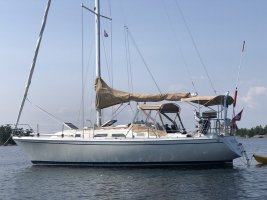
Thanks so much for all of this information and providing the pictures of what to expect behind the seat. I was just required a survey on our E34 and the surveyor wanted to see the chainplates but it was not doable. I'm considering removing the screw plugs as well so that they can be inspected more easily for upcoming surveys. Up in Ontario Canada, after 30 years, some insurance companies are requiring a survey every 5 years.
Just as has been echoed...the E34 for a dream boat.
Thanks again.

Attachments
Last edited:
supersailor
Contributing Partner
Technically, the E-34 does not have chain plates. It has Navitech rods that transfer the mast loads from the deck to the Tri Axial grid. There is no transfer of the load to a bulkhead. In fact, there is no bulkhead. It is possible to see the through deck contention by removing the headliner where the uppers and lowers are. You can see the Navitech Rods above the cupboards. To see the aluminum billet to triaxial grid connection, you need to rip off the seatback (it's glued and screwed on). If the inspector still wants to see the chain plates, perhaps it is time to find a more knowledgeable inspector.
I can provide pics of the rods if needed. My boat was the victim of a sinking incident. If you go to the Lifestyle &Living Forum, the second entry second page, you will see Terra Nova Flooding. In that thread, you will find way more than you ever wanted to know about your E-34. There are no wood connections to rot. The system is immensely strong and does not require a bulkhead. Good Luck!
I can provide pics of the rods if needed. My boat was the victim of a sinking incident. If you go to the Lifestyle &Living Forum, the second entry second page, you will see Terra Nova Flooding. In that thread, you will find way more than you ever wanted to know about your E-34. There are no wood connections to rot. The system is immensely strong and does not require a bulkhead. Good Luck!
Last edited:
"Terra Nova Flooding" : http://www.ericsonyachts.org/infoexchange/showthread.php?14156-Terra-Nova-Flooding
Navitech rods at post #31.
Navitech rods at post #31.
Last edited:
Rick R.
Contributing Partner
Find a new surveyor
Agree with Bob (above),,,....”””
In reading your post, I was struck with the thought that your surveyor might be more adept at checking property lines than boats. You have the same design as I do and Ericson made it easy to inspect the structure.
Step 1 - Remove cushions
Step 2 - Open beer
Step 3 - ...........
Agree with Bob (above),,,....”””
In reading your post, I was struck with the thought that your surveyor might be more adept at checking property lines than boats. You have the same design as I do and Ericson made it easy to inspect the structure.
Step 1 - Remove cushions
Step 2 - Open beer
Step 3 - ...........
Last edited:
supersailor
Contributing Partner
Thanks Christian. It's hard to find stronger built boats.

